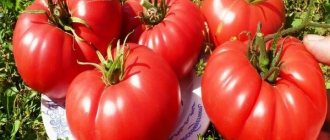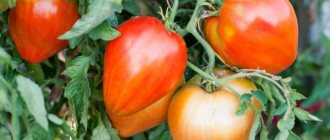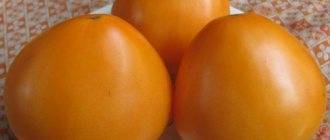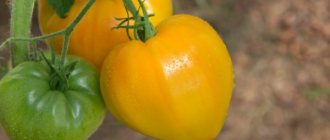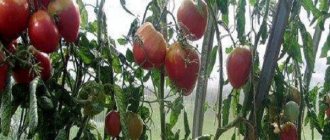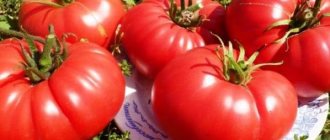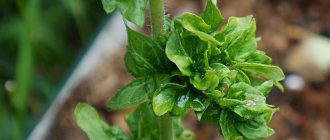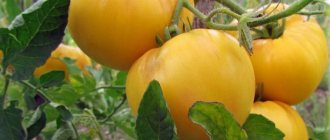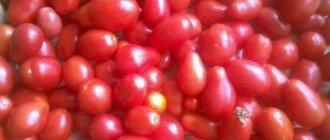Early, fleshy, bright red, shaped like a heart? These tomatoes are the favorites of all gardeners. The Lion Heart is one of the best representatives of the group. It is a pleasure to grow this variety and a real pleasure to eat.
| Height | Landing location | Ripening time | Fruit color | Fruit size | Origin | Fruit shape |
| Medium height | Greenhouse, Open ground | Early ripening | Reds | Large | Variety | Heart-shaped |
Description of the variety
This is an indeterminate variety, which, with proper care, will allow you to grow tasty and large fruits. Harvesting occurs 95-105 days from germination. Tomatoes are grown using the seedling method. Young plants can be planted in open ground 50 days after planting the seeds. In this case, the earth should be heated to a depth of 19 cm and up to 15-16 degrees. If you grow the tomato variety Heart of a Lion in closed ground, then planting work should be carried out in the first half of April, and in open ground - in the second half of May. Lion's heart is suitable for fresh consumption and preparation of high-quality tomato products. It is resistant to the following diseases:
- verticillium wilt;
- fusarium;
- late blight
A variety that will please you for many years - Em Champion tomato: description of tomatoes and characteristics
The Em champion variety, which breeders presented to farmers back in 1982, is not only highly productive. He's special. Large-fruited, perfectly fruiting in any region, disease-resistant and with ultra-class fruits.
| Height | Landing location | Ripening time | Fruit color | Fruit size | Origin | Fruit shape |
| Medium height | Greenhouse, Open ground | Mid-season | Reds | Large | Variety | Flat-round |
Description and characteristics of the variety
Tomato Em is a champion that has been tested by time and hundreds of thousands of gardeners. Reliable and stable.
- shoot height 60-65 cm;
- trunks are sparsely leafy, neat;
- leaves are ordinary, medium in size;
- the first bunch is formed after 5-7 leaves;
- all subsequent ones through 2 sheets;
- There are only 6-7 tomatoes on the bunches.
Ripening dates and growing regions
The yield of the harvest begins in the middle period. After 112-124 days, the first giants are removed from the shoots.
The variety is included in the Siberian collection. This means that the plants are maximally adapted to the difficult climate of Siberia, the Urals, and the Far East. Cultivation is carried out in all regions of the country:
- in the north under shelters with the possibility of heating;
- in temperate and southern regions in open beds, and, if necessary, in the first month with replanting under film.
Advantages and disadvantages
- highest productivity;
- simple agricultural techniques;
- presentable appearance;
- excellent taste criteria.
- transportability and keeping quality.
- resistance to temperature fluctuations.
Minuses:
need for fixation. the importance of fertilizing beds.
Features of cultivation and storage
It is advisable that the predecessors in the garden be carrots, beet, lettuce or green manure.
In order for the variety to lead and achieve maximum productivity, simple conditions are observed:
- They are planted sparingly - no more than 3 bushes per 1 m2.
- Complex fertilizers are applied regularly - at least 2 times a month.
- Water infused with shells and bio-infusions are used for irrigation.
- Mulch with a layer of 7-10 cm.
Planting and care
The seeds are planted to a depth of 1 cm. Sprinkle with a fine mixture on top. Irrigate moderately. Cover with film. Future seedlings are kept in boxes until seedlings emerge in greenhouse conditions. Maintain a temperature of 25-26 degrees.
Steps to successful seedlings:
- Picking with 2 leaves.
- Fertilizing with Agricola or Kemira.
- Irrigation with settled water.
- Hardening at a temperature of 14 degrees.
- Maintaining temperature 20 degrees and humidity 50%.
Characteristics of the variety
Lionheart is one of the best varieties for fresh consumption, and you may also be interested in knowing:
- that the fruits weigh on average 180-300 g;
- early-ripening and high-yielding type of tomato;
- characterized by high fruit set, the bush is medium leafy, its height is 120-140 cm;
- the plant is formed into two stems;
- The fruits are flat-round, smooth, dark red in color. They are meaty and very tasty;
- from 1 m2 you can harvest 14-19 kg of tomatoes.
Which indeterminate tomato varieties are the most productive for greenhouses?
There is a misconception that an indeterminate tomato variety is just a tall plant, but in fact this is what they mean for its unlimited height. If these types of crops are allowed to grow, they can reach two or even three meters. Therefore, you need to monitor their growth, otherwise getting tomatoes from such a height will be problematic.
The advantages of this variety include the fact that their growth continues until the first cold weather, they are resistant to diseases and are not afraid of temperature changes.
Advantages and disadvantages of indeterminate varieties
Indeterminate varieties can grow uncontrolled and produce good yields over a long period of time. They have thick leaves, on which tomatoes then appear, and are resistant to bad weather.
Tomatoes look like tall bushes with a single stem that performs the main function in the growth process. Rarely, but still, these bushes grow up to 5 meters.
Their flowering begins to develop after the first ten leaves, and then this continues every three shoots. Ripe tomatoes appear much later than other types, but this process lasts the longest.
When the crop reaches the ceiling of the greenhouse, at this moment it is necessary to cut off the top, or the tomatoes that are there will not have enough time to ripen. If you look at the descriptions of many indeterminate species, their height is observed from 1.5 to two meters. It is precisely because of their positive qualities and tolerance to temperature changes that such tomatoes are grown for sale. Among the disadvantages, it should be noted that it is recommended to tie the plant up to the crown so that it is well lit. Since seed ripening occurs late, you need to pay attention to this factor during planting.
The most productive indeterminate tomato varieties for greenhouses
Indeterminate varieties have no growth limit and can freely reach two meters, so their appearance is comparable to vines, which also grow randomly. But at the same time, shoots and flower clusters will appear on the bushes as they grow. Popular varieties:
Diana
Deciduous bushes can reach two meters in length, which need to be pinched back. An early-ripening hybrid, technical ripeness occurs 91-96 days after the appearance of sprouts. The fruits have a round shape, bright pink color, elastic skin that does not crack. The taste of tomatoes is sweetish with juicy pulp. There are three or four seed chambers, in which there are not many seeds. One tomato weighs 120-130 grams. The yield is about 18 kg. The advantages of the variety include its fertility, the possibility of transportation, good quality, and long storage. There is only one drawback - the bush needs to be tied up to prevent it from growing.
Ordynka
The plant is predisposed to a generative type of development, which allows it to bear fruit all summer long. The mid-season hybrid ripens 115-120 days after germination. Tomatoes have a round shape and are light green in color at the beginning of ripening and only then turn deep red. The peel is shiny and does not crack. The advantages of the variety also include its ability to be transported, long-term storage, pleasant taste, multi-chamber and average weight, which can vary from 190 grams to 220.
Belfast
The foliage of the bushes is quite dense, and the plant can reach three meters in length, which needs to be pinched, so it is so important to monitor their growth. An early ripening hybrid ripens 90-100 days after germination. Tomatoes have a round, red color and relatively soft flesh. One fruit weighs 250-580 grams. The yield is 26 kg. The advantages of the variety include the fact that the grown tomatoes can be used both for salads and for wrapping. The fruits have a strong peel and good transportability. They retain their taste and quality even after long storage. Resistance to common diseases. The only disadvantages of the tomato are that from the very bottom to the top its size is constantly changing, and it also does not have drought resistance.
Dimerose
A tall bush with a strong stem, good root system, and abundant fruitfulness. An early-ripening hybrid ripens 100-105 days after germination. The fruits are flat-round and pinkish in color with thin but elastic skin. They have 2-3 seed chambers containing a small number of seeds. One fruit weighs on average 200-250 grams. The harvest varies from one kilogram to three. The advantages of the variety include the sweetish taste of the fruit and its universal application to all types of cooking. Tomatoes can be transported and stored for quite a long time. It is moderately resistant to manifest diseases. The only drawback is that growing the Dimerosa variety is only possible under a greenhouse or in a greenhouse.
Scarlet Mustang
Bushes can reach more than one and a half meters in height, so you must not forget to tie them up. The leaf mass is not thick, which does not interfere with the ripening of a new crop. The root system of this variety is quite large and capable of growing. The mid-season crop ripens 115-120 days after germination. The fruits have an elongated shape, juicy pulp with a pleasant taste. One tomato weighs about 200 grams, but sometimes more. The yield from one bush is five kilograms. The advantages of the variety include the thin but dense skin of the fruit, which does not crack, and their resistance to various diseases. They can be transported from place to place, and tomatoes have a universal value in the food environment.
For greater fruitfulness of tomatoes, it is recommended to lightly shake the bushes once every 7-10 days to allow cross-pollination to occur.
It is impossible to obtain a bountiful harvest from indeterminate varieties if the bush is not formed in time and pinching is not carried out. The culture must be provided with enough space so that each plant receives adequate nutrition.
Features of cultivation
In order for the harvest to be good, you will need to follow several tips.
Preparatory activities
Sow Lionheart seeds in late March-early April. To do this you will need the following materials and tools:
- Capacity. Use a container with a depth of 5-7 cm. For the first picking, a pot of 10-15 cm is suitable, and for the second, the height of the container will be 20-30 cm.
- Soil . Purchase a ready-made substrate for tomatoes in a specialized store. Before using it, disinfect it by heating it in the oven to 100 degrees.
- Planting material. They can be sown without preparation, or first kept for 15-20 minutes in a bright pink solution of potassium permanganate, and then rinsed with water.
Planting seedlings
Procedure:
- Pour the substrate into containers so that there is a 2-3 cm border to the top. Water the soil.
- Place planting material on top, maintaining a distance of 2x2 cm.
- Sprinkle with a thin layer of earth (1 cm) and tamp down a little.
- Cover the container with glass and place in a warm place.
Growing seedlings
When 3-7 days have passed since sowing, the first shoots will appear. From now on, caring for seedlings involves observing the following actions:
- Remove the covering material and move the container to a bright place.
- Water the seedlings with warm and settled water as the soil dries out. During the first moisturizing, add potassium permanganate to the water until it turns pink. This is an excellent prevention against blackleg.
- 7 days after germination, when 1-2 leaves appear, pick, transplanting the plants into larger boxes and following a 5x5 cm pattern.
- If the plants are too elongated, then deepen them to the cotyledon leaves.
- As soon as the bushes in the container begin to touch each other with their leaves, and their above-ground part in volume exceeds the size of the earthen lump in the pot, then this is the time for the second picking. By this period, warm weather has set in, so the seedlings can be placed on a glassed-in balcony, in a greenhouse.
- During the entire period of growing seedlings, fertilize 3-4 times with an interval of 10-14 days. Use complex formulations, for example, Fertika Lux. To prepare the solution, take 20 g of the drug and 10 liters of water. After picking, carry out the first feeding no earlier than 7 days later.
Planting in open ground
Carry out planting work in open ground only after the threat of frost has passed. Most often this happens after June 5-7.
Do not plant tomatoes in the same place for several years in a row. Do not place bushes after potatoes, physalis, peppers and eggplants.
Procedure:
- The place should be thoroughly illuminated by sunlight, and there should be no trees or shrubs nearby.
- Sprinkle a nutrient composition prepared from 10 kg of humus and 500 g of wood ash over the area. This is enough for 1 m2. You can use finished products: Sudarushka, Gumi-Omi, Agricola.
- Dig up and level the soil surface.
- Arrange the bushes according to a 40x50 cm pattern, tie each one to a peg.
- During the first week, while the plants take root, the soil should be moist. To do this, use mulch from hay or grass clippings.
- For quick establishment, treat the seedlings with a stimulant solution. The drug Energen (1 capsule per 1 liter of water) is suitable.
Transplantation and propagation
There are two ways to propagate snapdragons: by dividing the bush and using seedlings. A unique species feature is the ability of seeds to be stored in the ground for several years and then to germinate on their own.
Seedlings can significantly speed up the growing process. The seeds are planted in a special box with drainage holes. Pebbles, expanded clay or any other drainage filler are poured into the bottom. The basis is a light, loose substrate based on turf, peat and sand with the addition of ash and humus. First, the soil is filled with a weak solution of potassium permanganate.
Disinfected seeds are mixed with sand and sown in even paths at intervals of several centimeters. They are covered with a small amount of soil on top and sprayed with water. The container is covered with film or covered with glass. It needs to be ventilated every day, moistened as it dries, and stored at a temperature above +17C. The first shoots are noticeable within a week and a half. Another week after this, the film can be removed.
When the first couple of leaves appear, the seedlings can be distributed into flowerpots using peat pots. Intermediate replanting in the future promotes bushiness and better flowering.
By the end of spring, the seedlings can be transplanted into the ground. The ideal soil is loam or sandy soil. It performs two main options: water permeability and ventilation. Ash, complex fertilizers, humus and peat promote flowering. Also, for intense and long-lasting flowering, you need a lot of sun.
Care
Further care of plants planted in open ground requires the following actions:
- Garter. Since the bushes are tall, they should be tied to a support so that they do not break during the wind. Install support stakes, 2 m high and 5 cm in diameter, near each bush. Attach tomato shoots to the supports using a rope.
- Mulching. Cover the top layer of soil with straw or bark mulch. Due to such shelter, moisture will remain in the ground longer.
- Irrigation. Lionheart requires abundant watering. Then the fruits will be large and sunny. But for this, the water must be prepared. Defend it so that all harmful impurities precipitate.
- Pollination. This process is negatively affected by weather conditions, so you will have to take care in advance to attract insects. For these purposes, plant honey plants between the beds. During the flowering period, tomatoes need to be helped to pollinate by tapping on the pegs. Then the pollen will fall on other flowers.
- Stepsonning. First, leave 1,2 or 3 strong shoots and remove the rest. Also trim growing stepsons 5-7 cm and lower leaves. Pinch the tops of the bush so that the plant does not grow upward.
- Application of fertilizers. Nutrient formulations are required throughout the summer. Apply them every 1.5 weeks until the fruits ripen. At this time, use fertilizers enriched with fluoride. When fruits begin to form, formulations with increased concentrations of nitrogen and potassium will be required.
Description of the Buffalo Heart tomato and cultivation in open ground
The Buffalo Heart tomato is a low-growing but large-fruited variety. It was bred by Russian breeders at the beginning of the 21st century. This variety has many advantages, for which it has received positive reviews from vegetable growers. It is low-growing, but bears large fruits, similar to a heart. Refers to non-hybrid vegetable crops. You can save the seeds for planting next season.
Characteristics of the variety
The characteristics and description of the variety are as follows:
- Buffalo Heart tomatoes are intended for cultivation throughout Russia. There are no special recommendations for choosing a region. The variety takes root and produces good fruits both in the northern regions and in the south.
- Medium early tomatoes. The plant begins to bear fruit 115 days after planting the seedlings. Summer residents receive their first harvest in July.
- Tomatoes are planted both in a greenhouse and in open ground. It is not dependent on weather conditions. Withstands slight drought, rain and frost.
- The variety is determinate, that is, low-growing. The bushes are standard, rather frail. There are few leaves. The average plant height is about 80 cm; in greenhouses, a tomato grows up to 1 m.
- Buffalo Heart tomatoes are practically not susceptible to common diseases and insect pests. This makes the variety attractive to both experienced gardeners and beginners.
Buffalo Heart tomatoes are a rich red color with a hint of pink.
- These are large, round-heart-shaped tomatoes.
- Each fruit weighs from 500 g to 1 kg.
- The pulp is dense, fleshy, juicy.
- Minimum number of seeds and chambers.
- The peel is smooth, glossy, thin.
- Classic tomato taste.
- The tomato is sweet with pleasant sourness.
- 3-5 tomatoes are tied in one brush.
- They ripen well and are stored at home.
- They can handle transportation without any problems.
The variety bears fruit for a long time. Summer residents who grow Buffalo Heart from mid-summer to early autumn always have fresh tomatoes on their table. This property of the variety also makes it suitable for commercial cultivation. Productivity is good. With proper care, one bush produces 10 kg of fleshy tomatoes per season.
The variety belongs to the salad variety.
Buffalo heart is not suitable for preservation due to the large size of the fruit. Dishes prepared from tomatoes:
- Various salads.
- Tomato paste.
- Juice.
- Sauces.
- Snacks.
- Ketchup.
How are tomatoes grown?
The Buffalo Heart tomato is planted in open ground as seedlings. Seeds are planted in boxes with soil in March. Each seed is sown to a depth of 1 cm. The soil for the tomatoes is fertile. Then water it with a spray bottle and cover it with film to create comfortable conditions for seed germination.
Within a week, shoots should appear. As soon as several strong leaves grow from each seed, the seedlings can be planted in separate cups. Seedlings are transplanted into open ground or a greenhouse 2 months after planting. The plants should first be hardened off and accustomed to the street. To do this, a few weeks before transplanting them into open ground, they begin to take them outside or onto the balcony.
The hardening time is gradually increased. This way, replanting will not cause stress to the plants, and the tomatoes will take root better. Everyone who has planted this species says that the seedlings are noticeably different from other varieties. The shoots are quite thin and long. As soon as the plant is transferred to the ground, it gains strength.
Bushes are placed 4 pieces per 1 m². During planting, the plants are fed with fertilizers, the ground is sprinkled with ash, and the holes are watered abundantly. Tomatoes are watered with warm water once every few days. The Buffalo Heart variety loves moderate watering. However, you need to ensure timely removal of weeds and loosening of the soil under the bushes.
Experienced gardeners know that the plant needs to be pruned on time. The bushes should not be allowed to grow, so that they do not waste energy on unnecessary shoots, but spend it on ripening the fruits.
The variety is not susceptible to the most common diseases. However, it is best to prevent diseases. To do this, the plant is treated with insecticidal substances.
A greenhouse or greenhouse must be ventilated periodically to avoid causing mold.
High humidity in a greenhouse will not benefit the vegetable crop. In good weather, the greenhouse is opened for the whole day and closed only at night. To increase the yield, the bushes are fed several times a season with fertilizers, which can be purchased in specialized stores.
Diseases and pests
Lionheart is a variety characterized by strong immunity to disease. Late blight can affect plants only if they are not properly cared for. This is a fungal disease that causes significant damage to crop yields. It can be recognized by the presence of rot on all elements of the crop and wilting of the inflorescences.
As soon as the first signs are detected, remove all affected parts and treat the bush itself with fungicidal preparations.
The following insects are dangerous pests:
- whitefly;
- mole cricket;
- aphid;
- Colorado beetle.
Insecticides are used to control pests.
List of advantages and disadvantages
Tomato demonstrates enviable productivity indicators. One bush, depending on the planting method, produces from 3.5 to 4 kg of fruit. The crop has good shelf life and can withstand the stress associated with transportation. Tomatoes also have other advantages:
- Versatility in use in the kitchen. Tomatoes are salted, fermented, canned whole and chopped, eaten in fresh salads, ground into pastes, sauces or sweet juices.
- Compact bush in the garden. Thanks to this, planting on the site can be quite dense.
- Increased immunity to most typical tomato diseases.
Negative characteristics of tomato:
- has brittle stems - does not develop normally without a garter to a support;
- requires competent formation.
Attention! Step-sonning is optional. The bush is growing normally. Gardeners sometimes omit the procedure.
Photo
The Lionheart tomato is an excellent choice for growing both outdoors and indoors. It is not demanding in care, resistant to diseases and produces a high yield. Even a beginner can grow it and enjoy delicious vegetables.
How to grow seeds in pots
If you want to decorate your garden plot, then you should use the following methods for breeding snapdragons:
Snapdragon growing from seeds: when to plant
This method is complex, since in order for the seedlings to germinate, they require careful care. If the seeds do not receive enough heat, the seedlings will not be able to sprout, which means that you will not be able to get a beautiful flower garden with blooming antirrhinum.
Sowing of seeds is carried out in March and for this you will need:
- Seeds of the selected variety.
- A small spatula and a regular sieve.
- Soil mixture.
- A special pot in which the seedlings will be sown.
It is necessary to fill the selected container with soil. The soil should not be heavy; you can buy it at any store. Place the seeds thickly and press them down lightly with your finger. Be sure to cover with a thin layer of soil substrate using a sieve for this purpose. After planting, the seedlings must be moistened and covered with film.
In order for seedlings to germinate for sure, they need a temperature of at least 20-23 degrees. As soon as the first borings appear, be sure to harden them. Open the film on the containers each time, increasing the hardening time. Over time, the film should be completely removed.
When and how to sow dogs video review:
Growing using seedlings.
The most common way. Seedlings are grown indoors, and as soon as the seedlings appear, they must be transplanted into open ground or a container.
When should antirrinum seedlings be planted in the ground?
Doggy flowers
After the seedlings have been hardened and thoroughly strengthened, they must be planted in open ground. This procedure is carried out at the end of May days or at the beginning of June days. There is no need to worry about the slight cold that is still present at night, because your hardened plants will cope with them without much difficulty.
The plant prefers to grow in sunny or slightly shaded areas, where there are no strong winds that can break the delicate, although quite flexible, branches.
The only main condition for successful flower growing is thorough soil drainage.
Light, nutrient-rich soil is suitable for planting.
For the snapdragon to feel great, it will need soil consisting of:
- vegetable compost
- river sand
- peat
All of them are used in equal quantities.
Watering and fertilizing
It will take about two weeks for the seedlings to take root. After this, the plant is first fertilized with organic fertilizer. This can be nitrophoska or another fertilizer that contains the microelement boron.
Further feeding is done every two weeks all summer and until late autumn. To do this, you can prepare a mixture of superphosphate, sulfate and urea.
Snapdragon flowers need constant watering, but excess moisture can destroy the plant. Therefore, it is better to water antirrinum as the soil dries out. And to maintain the required level of moisture, you can mulch the soil with freshly cut grass or humus.
Don't forget to water the antirrinum regularly!
Beautiful, well-groomed flowers of antirrinum
Temperature
For normal growth and good development of snapdragons, the average air temperature should be 22-25°C. But this flower is very resistant to cold. Therefore, it can survive even slight frosts: -3-4°C.
Air humidity
Due to insufficient air humidity, snapdragons may drop their leaves and stop flowering. Therefore, the plant must be sprayed with warm water.
Regular spraying with warm water will restore freshness and brightness to the flowers.
Wonderful snapdragons are the subject of admiration for guests and the pride of the gardener
Lighting
Flowers love open sunny space. Antirrinum will, of course, withstand partial shade, but it will stretch out and bloom poorly. Whatever place you choose to grow snapdragons, the main condition is that it is protected from the piercing wind.
Plant pruning
To create bouquets, cut varieties are regularly pruned. This increases the period of decorative flowering. From other varieties, the sluggish inflorescences are only removed, which entails a further increase in the flowering of snapdragons.
Snapdragons look very impressive both in a flowerbed and in bouquets
Delicate white Snapdragons look very impressive next to other bright flowers, such as poppies
A riot of colors of multi-colored snapdragons in a hanging planter
Growing snapdragons from seeds
Sowing
This plant can be propagated by seeds or by vegetative means. The seeds have good germination for several years. If you live in an area with a relatively mild climate, then sowing the seeds of such a flower can be done directly into open soil. The first shoots can be seen after 2.5–3 weeks, while the seedlings are not afraid of cold snaps that occur at night. In places where spring is relatively cold, this plant is recommended to be grown through seedlings. Growing snapdragons from seeds is very easy.
Seeds are sown in the first days of March. To do this, you will need a bowl with a diameter of at least 10 centimeters, and it should have holes at the bottom for drainage. Coarse sand should be poured onto the bottom, and compost soil mixed with sand should be placed on top of it. Lightly compact and level the surface, then moisten it a little with a spray bottle and distribute snapdragon seeds mixed with sand, pour a thin layer of the same substrate on top. Water the crops using a fine spray bottle, and then cover the container with clear glass. Every day, condensation must be removed from the surface of the glass, while ventilating the seedlings and, if necessary, moistening the surface of the substrate with a sprayer. If the place where the container is located has moderate humidity and warmth (23 degrees), then the first seedlings can be seen after half a month. After the first plants appear, the container must be moved to a well-lit place, but at the same time protected from direct rays of the sun (so that the plants do not stretch out). After the snapdragon begins to emerge en masse (after 3–4 days), the shelter must be removed for good.
Seedling
At first, the plants will grow for quite a long time, and during this period it is especially important to properly moisten the soil. Watering should be done in the morning so that the plants have enough moisture, but not too much. The fact is that waterlogging can cause the development of “black leg”. If the seedling has fallen, it should be carefully removed using tweezers, and the place where it grew should be sprinkled with crushed charcoal or calcined cold river sand should be used for this. After 2 true leaves are formed, the seedlings must be picked into a box or container, and they must be placed so that they are not pressed against each other. You can also use individual pots for picking plants, or you can plant 3 seedlings at once in 1 larger pot. Then the plants should be placed in a well-lit place, but at the same time protected from direct sunlight. After this, you can begin hardening the seedlings. To do this, during the daytime you need to open the window for a while, but you should avoid drafts. When the plant has 4-5 true leaves, it will need to be pinched to increase bushiness, but if the side shoots grow quite quickly, then they should also be pinched.
Sources
- https://prodachnika.com/ogorod/tomaty/tomat-serdtse-lva.html
- https://klumbavsadu.com/lvinyj-zev-posadka-i-uhod.html
- https://happymodern.ru/lvinyj-zev-50-foto-sposoby-razmnozheniya-posadka-i-uxod-za-rasteniem/
- https://Trizio.ru/lvinyy-zev-65-foto-816
- https://rastenievod.com/lvinyj-zev.html
- https://DachaMechty.ru/tomat/uhod/lvinoe-serdtse.html
[collapse]
What types and varieties of snapdragons are found?
Professional gardeners classify snapdragons by their height. So you can find five different types, including:
Gigantic or gigantella
Height from 90 to 130 cm. The central stems are very tall.
Shoots of the second order are much lower, while the third order is completely absent. Favorite varieties:
- Arthur – rich cherry color, up to 100 cm high
- F1 red XL of the same color growing more than 1 meter
- F1 pink XL grows up to 110 cm and its color is correspondingly deep pink
- "The Rose" its flowers are distinguished by the exceptional shine of pink pearls
- Snapdragon Opus red is the most popular of this extensive series, with colors ranging from pink to lavender
Tall varieties
Can vary from 60 to 90 cm in height. As a rule, these varieties are grown for cutting, as well as as accent flowers in group compositions. The central shoot is quite high in relation to the side shoots. Yellow varieties have an unforgettable delicate aroma. A cut snapdragon of this type will delight you for a week.
Popular varieties:
- Mix of varieties Madama Butterfly - double snapdragon of various shades
- "Canary" yellow-canary color
- "Anna German" flowers mostly in the most delicate shades of pink
- "Maxi Orange Wonder" salmon - orange gigantic inflorescences
- “Goshenka” fiery orange mouths
- "Rocket Lemon" truly lemony
- "Rocket Orchid" cornflower blue flowers
- "Rocket Bronze" salmon flowers, with unexpected orange tints and yellow intros
- "Alaska" green snapdragon with white spots
- "Volcano" flowers of various shades of orange
- “Swallowtail” a combination of colors, like a butterfly, yellow and crimson
- "Velvet Giant" (large and velvety-looking flowers of purple-black tones
- "Brilliantrosa" very fragrant pink dogs
Average
Or semi-tall universal varieties, the length of which does not exceed 60 cm, are grown both as an excellent decoration for flower beds and for cutting into bouquets.
It differs from other varieties by excessive branching. In addition, unlike its predecessors, it has a central stem of almost the same height as the side shoots.
Common varieties:
- Ruby "Rubi" hot pink tone
- Lipstick silver "'Lipstick Silver" soft pink and white
- Snapdragon Day and Night "Tag und Nacht". It has contrasting white and red flowers - dogs that do not fade under the scorching rays of the sun or fall from gusts of wind. Another name is Queen of the Night.
- "Rosella" and "Wildrose" pink snapdragon
- 'Libesglut' red-ruby blenny flowers
- "Scarlet Monarch" blood burgundy color
- "White Monarch" snow-white flowers
- Golden Monarch "Golden Monarch" yellow royal flowers
- "Bizari" hybrid snapdragon blooming with yellow flowers with dots and streaks of a darker tone
short
The height of these plants can vary from 25 to 40 cm. They serve as a good decoration for flower beds and borders. Shoots located in the second and third order are endowed with many flowers. The central part of the plant is almost the same height as the stems of the first order.
Popular varieties:
- Hobbit "Hobbit" with its very open mouth - the flowers can be of different colors: white, pink, and also peach, orange, mostly all sunny
- Tip-top, delicate pink color with a edging the color of real yolk
- “Peach and cream” are compact and sturdy, blooming with lovely flowers of a creamy-peach tonality.
- “Lemon sherbet” frost-resistant specimens blooming with fragrant flowers, painted in lemon-canary color
- “A ray of sunshine” this plant produces fragrant, rich yellow flowers throughout the entire summer season.
- Ampelous hybrid snapdragon undersized – Lampion
- Snappie orchid - a pinkish flower with a bright spot in the middle, looks like a magnificent orchid
- Rainbow mix "Rainbow" all kinds of colors.
Dwarf snapdragon
Plants do not exceed a height of 20 cm. They are planted to decorate borders, carpet beds and alpine slides. In addition, you can grow them in pots and decorate your balcony or terrace.
A distinctive feature of this species is that the central shoot is slightly lower than the stems of the second category. Shoots of the third and fourth order are endowed with excessively branching branches.
